Comprehensive Analysis of Corporate Accounting Case Studies, ACC5215
VerifiedAdded on 2023/04/21
|12
|2649
|124
Case Study
AI Summary
This document provides a comprehensive analysis of several corporate accounting case studies. The case studies delve into various aspects of corporate accounting, including different types of companies under Australian Accounting Standards, financial reporting perspectives, and the roles of key regulatory bodies like the Financial Reporting Council (FRC) and the Australian Securities and Investments Commission (ASIC). The analysis covers topics such as share warrants, share call options, the concept of control under IFRS 10, business combinations, and the consolidation of financial statements. The document explores the application of accounting standards like IFRS 3 and SIC-33, providing insights into practical scenarios and the implications of these standards. The cases also address how companies set up trusts. Each case study is examined with relevant theories and practical applications, making this a useful resource for students studying corporate accounting.
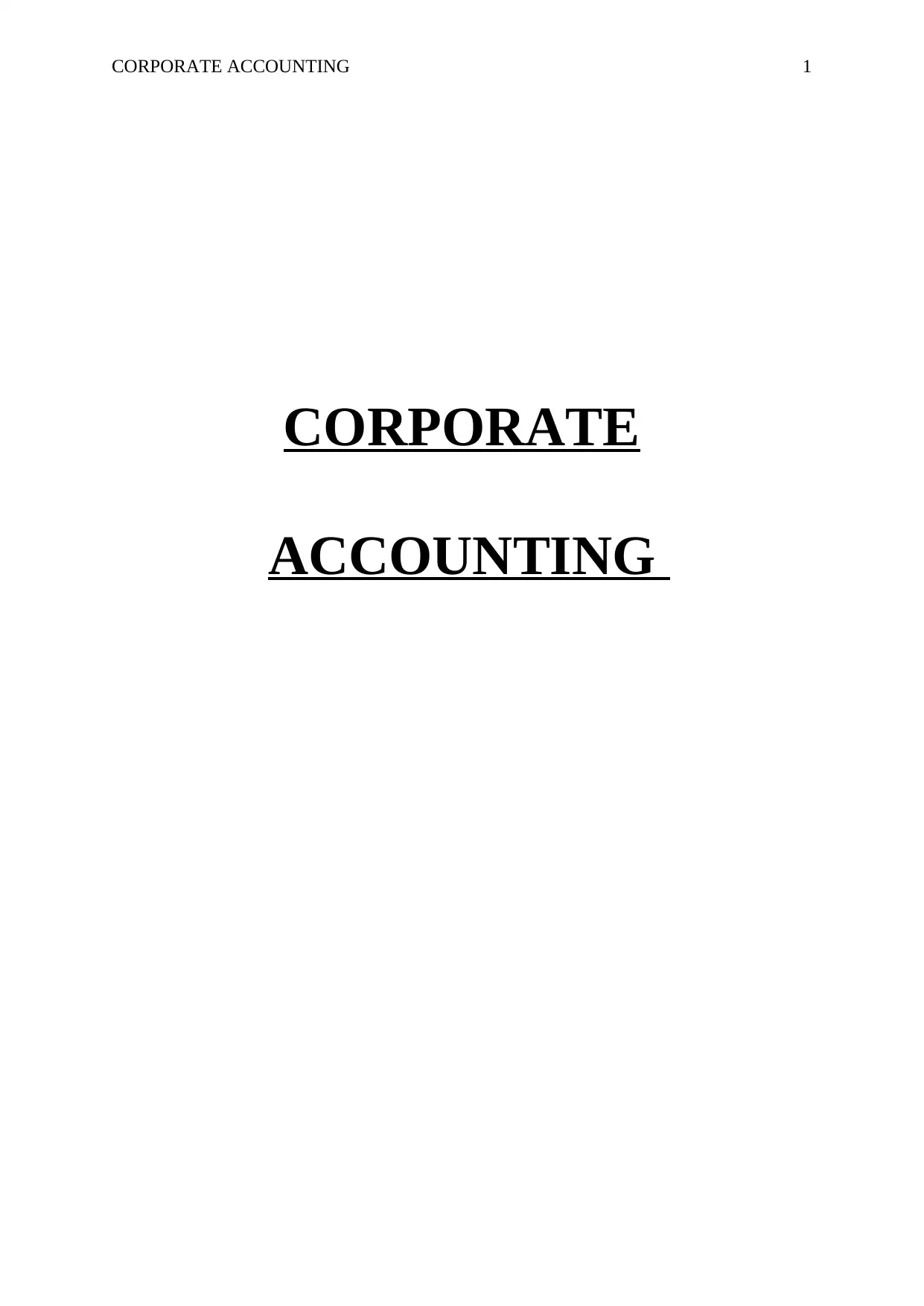
CORPORATE ACCOUNTING 1
CORPORATE
ACCOUNTING
CORPORATE
ACCOUNTING
Paraphrase This Document
Need a fresh take? Get an instant paraphrase of this document with our AI Paraphraser
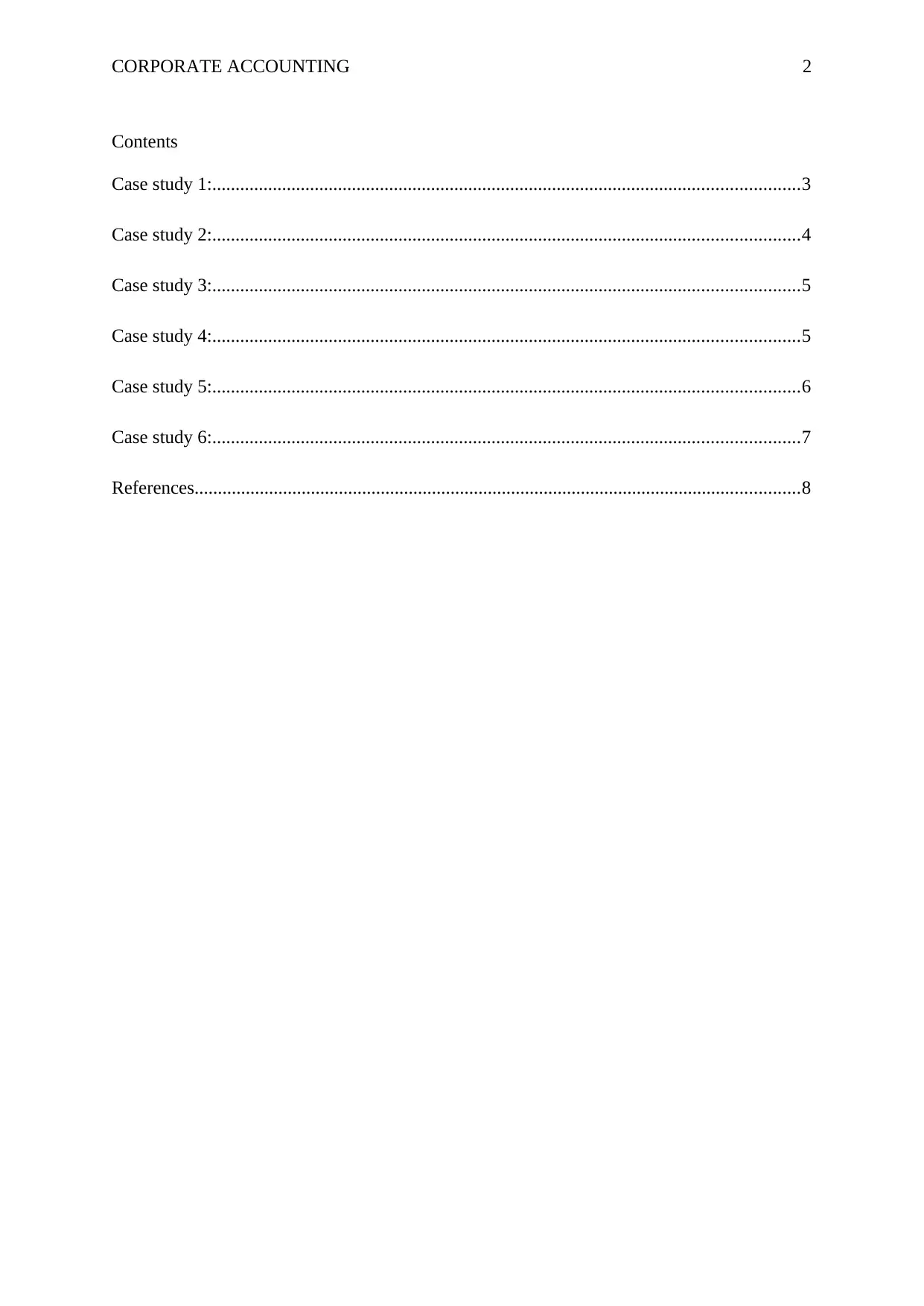
CORPORATE ACCOUNTING 2
Contents
Case study 1:..............................................................................................................................3
Case study 2:..............................................................................................................................4
Case study 3:..............................................................................................................................5
Case study 4:..............................................................................................................................5
Case study 5:..............................................................................................................................6
Case study 6:..............................................................................................................................7
References..................................................................................................................................8
Contents
Case study 1:..............................................................................................................................3
Case study 2:..............................................................................................................................4
Case study 3:..............................................................................................................................5
Case study 4:..............................................................................................................................5
Case study 5:..............................................................................................................................6
Case study 6:..............................................................................................................................7
References..................................................................................................................................8
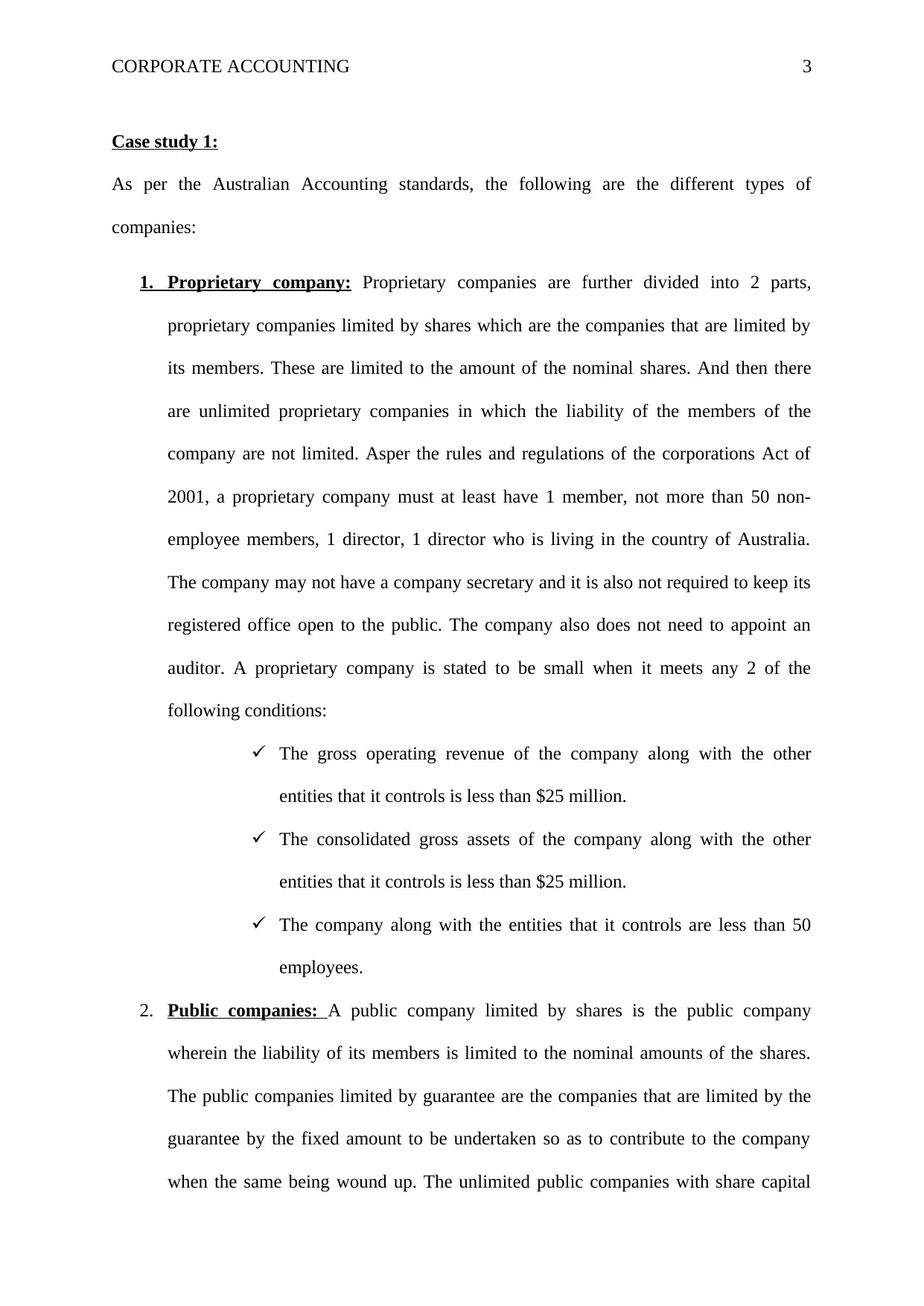
CORPORATE ACCOUNTING 3
Case study 1:
As per the Australian Accounting standards, the following are the different types of
companies:
1. Proprietary company: Proprietary companies are further divided into 2 parts,
proprietary companies limited by shares which are the companies that are limited by
its members. These are limited to the amount of the nominal shares. And then there
are unlimited proprietary companies in which the liability of the members of the
company are not limited. Asper the rules and regulations of the corporations Act of
2001, a proprietary company must at least have 1 member, not more than 50 non-
employee members, 1 director, 1 director who is living in the country of Australia.
The company may not have a company secretary and it is also not required to keep its
registered office open to the public. The company also does not need to appoint an
auditor. A proprietary company is stated to be small when it meets any 2 of the
following conditions:
The gross operating revenue of the company along with the other
entities that it controls is less than $25 million.
The consolidated gross assets of the company along with the other
entities that it controls is less than $25 million.
The company along with the entities that it controls are less than 50
employees.
2. Public companies: A public company limited by shares is the public company
wherein the liability of its members is limited to the nominal amounts of the shares.
The public companies limited by guarantee are the companies that are limited by the
guarantee by the fixed amount to be undertaken so as to contribute to the company
when the same being wound up. The unlimited public companies with share capital
Case study 1:
As per the Australian Accounting standards, the following are the different types of
companies:
1. Proprietary company: Proprietary companies are further divided into 2 parts,
proprietary companies limited by shares which are the companies that are limited by
its members. These are limited to the amount of the nominal shares. And then there
are unlimited proprietary companies in which the liability of the members of the
company are not limited. Asper the rules and regulations of the corporations Act of
2001, a proprietary company must at least have 1 member, not more than 50 non-
employee members, 1 director, 1 director who is living in the country of Australia.
The company may not have a company secretary and it is also not required to keep its
registered office open to the public. The company also does not need to appoint an
auditor. A proprietary company is stated to be small when it meets any 2 of the
following conditions:
The gross operating revenue of the company along with the other
entities that it controls is less than $25 million.
The consolidated gross assets of the company along with the other
entities that it controls is less than $25 million.
The company along with the entities that it controls are less than 50
employees.
2. Public companies: A public company limited by shares is the public company
wherein the liability of its members is limited to the nominal amounts of the shares.
The public companies limited by guarantee are the companies that are limited by the
guarantee by the fixed amount to be undertaken so as to contribute to the company
when the same being wound up. The unlimited public companies with share capital
⊘ This is a preview!⊘
Do you want full access?
Subscribe today to unlock all pages.

Trusted by 1+ million students worldwide
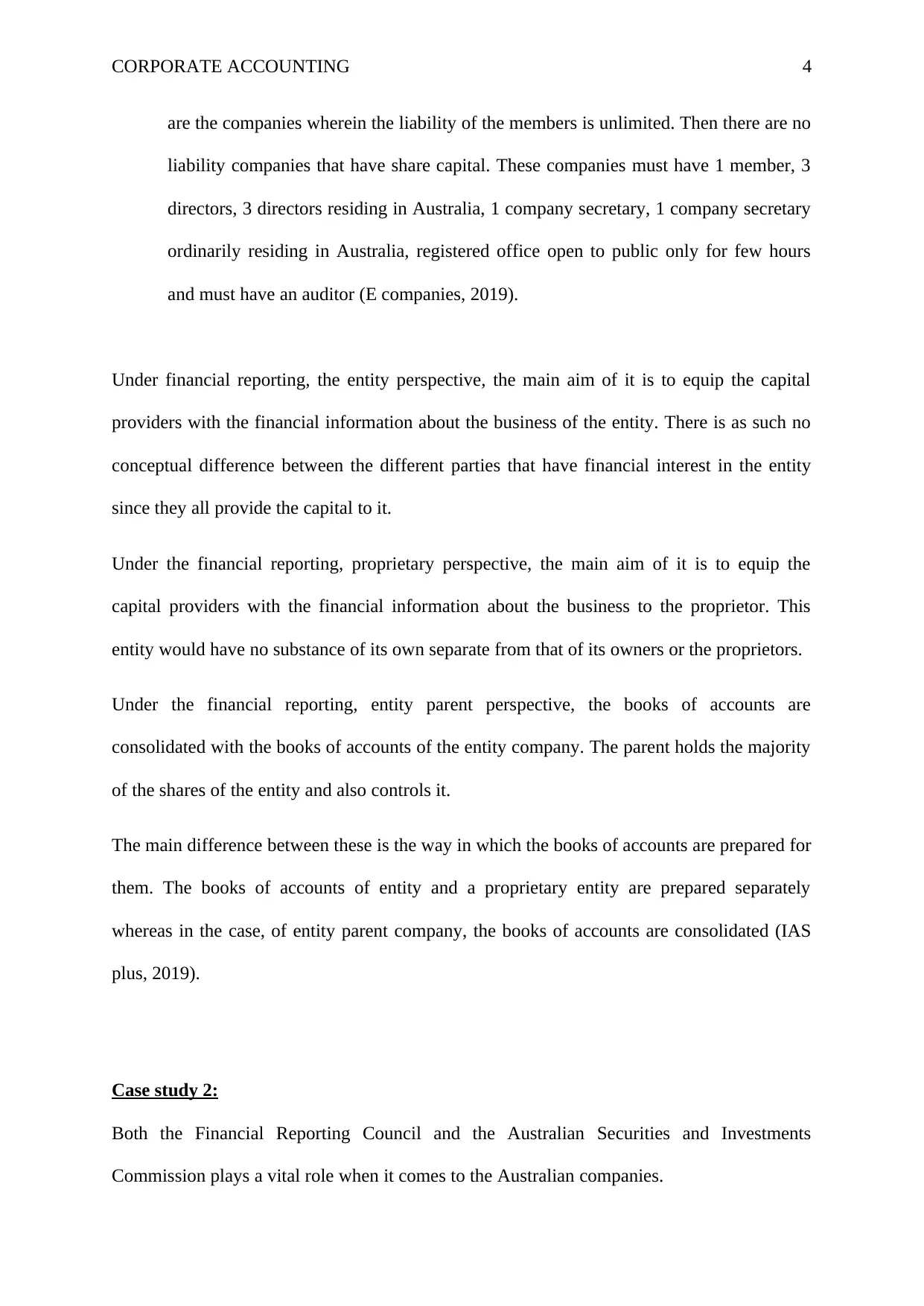
CORPORATE ACCOUNTING 4
are the companies wherein the liability of the members is unlimited. Then there are no
liability companies that have share capital. These companies must have 1 member, 3
directors, 3 directors residing in Australia, 1 company secretary, 1 company secretary
ordinarily residing in Australia, registered office open to public only for few hours
and must have an auditor (E companies, 2019).
Under financial reporting, the entity perspective, the main aim of it is to equip the capital
providers with the financial information about the business of the entity. There is as such no
conceptual difference between the different parties that have financial interest in the entity
since they all provide the capital to it.
Under the financial reporting, proprietary perspective, the main aim of it is to equip the
capital providers with the financial information about the business to the proprietor. This
entity would have no substance of its own separate from that of its owners or the proprietors.
Under the financial reporting, entity parent perspective, the books of accounts are
consolidated with the books of accounts of the entity company. The parent holds the majority
of the shares of the entity and also controls it.
The main difference between these is the way in which the books of accounts are prepared for
them. The books of accounts of entity and a proprietary entity are prepared separately
whereas in the case, of entity parent company, the books of accounts are consolidated (IAS
plus, 2019).
Case study 2:
Both the Financial Reporting Council and the Australian Securities and Investments
Commission plays a vital role when it comes to the Australian companies.
are the companies wherein the liability of the members is unlimited. Then there are no
liability companies that have share capital. These companies must have 1 member, 3
directors, 3 directors residing in Australia, 1 company secretary, 1 company secretary
ordinarily residing in Australia, registered office open to public only for few hours
and must have an auditor (E companies, 2019).
Under financial reporting, the entity perspective, the main aim of it is to equip the capital
providers with the financial information about the business of the entity. There is as such no
conceptual difference between the different parties that have financial interest in the entity
since they all provide the capital to it.
Under the financial reporting, proprietary perspective, the main aim of it is to equip the
capital providers with the financial information about the business to the proprietor. This
entity would have no substance of its own separate from that of its owners or the proprietors.
Under the financial reporting, entity parent perspective, the books of accounts are
consolidated with the books of accounts of the entity company. The parent holds the majority
of the shares of the entity and also controls it.
The main difference between these is the way in which the books of accounts are prepared for
them. The books of accounts of entity and a proprietary entity are prepared separately
whereas in the case, of entity parent company, the books of accounts are consolidated (IAS
plus, 2019).
Case study 2:
Both the Financial Reporting Council and the Australian Securities and Investments
Commission plays a vital role when it comes to the Australian companies.
Paraphrase This Document
Need a fresh take? Get an instant paraphrase of this document with our AI Paraphraser
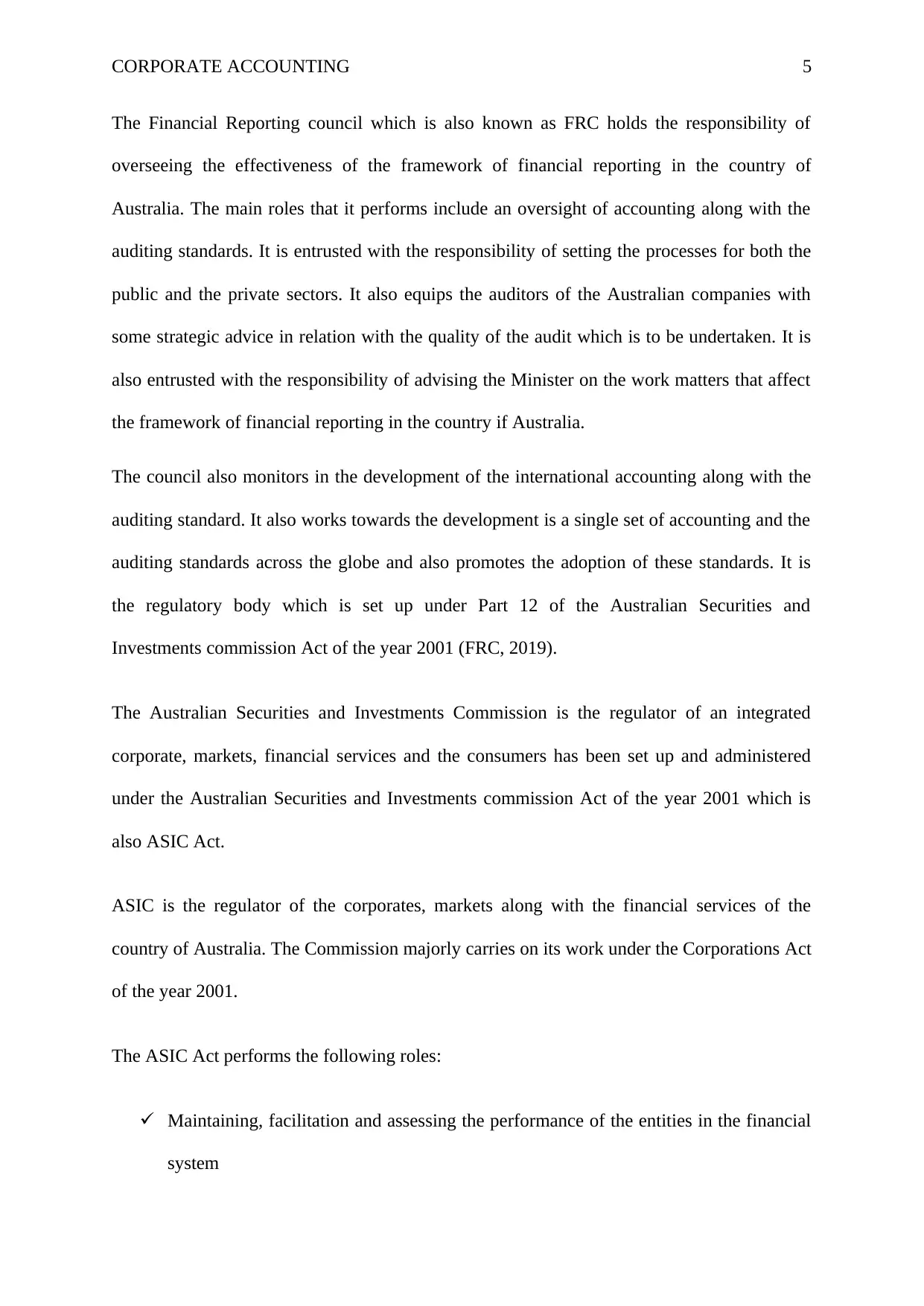
CORPORATE ACCOUNTING 5
The Financial Reporting council which is also known as FRC holds the responsibility of
overseeing the effectiveness of the framework of financial reporting in the country of
Australia. The main roles that it performs include an oversight of accounting along with the
auditing standards. It is entrusted with the responsibility of setting the processes for both the
public and the private sectors. It also equips the auditors of the Australian companies with
some strategic advice in relation with the quality of the audit which is to be undertaken. It is
also entrusted with the responsibility of advising the Minister on the work matters that affect
the framework of financial reporting in the country if Australia.
The council also monitors in the development of the international accounting along with the
auditing standard. It also works towards the development is a single set of accounting and the
auditing standards across the globe and also promotes the adoption of these standards. It is
the regulatory body which is set up under Part 12 of the Australian Securities and
Investments commission Act of the year 2001 (FRC, 2019).
The Australian Securities and Investments Commission is the regulator of an integrated
corporate, markets, financial services and the consumers has been set up and administered
under the Australian Securities and Investments commission Act of the year 2001 which is
also ASIC Act.
ASIC is the regulator of the corporates, markets along with the financial services of the
country of Australia. The Commission majorly carries on its work under the Corporations Act
of the year 2001.
The ASIC Act performs the following roles:
Maintaining, facilitation and assessing the performance of the entities in the financial
system
The Financial Reporting council which is also known as FRC holds the responsibility of
overseeing the effectiveness of the framework of financial reporting in the country of
Australia. The main roles that it performs include an oversight of accounting along with the
auditing standards. It is entrusted with the responsibility of setting the processes for both the
public and the private sectors. It also equips the auditors of the Australian companies with
some strategic advice in relation with the quality of the audit which is to be undertaken. It is
also entrusted with the responsibility of advising the Minister on the work matters that affect
the framework of financial reporting in the country if Australia.
The council also monitors in the development of the international accounting along with the
auditing standard. It also works towards the development is a single set of accounting and the
auditing standards across the globe and also promotes the adoption of these standards. It is
the regulatory body which is set up under Part 12 of the Australian Securities and
Investments commission Act of the year 2001 (FRC, 2019).
The Australian Securities and Investments Commission is the regulator of an integrated
corporate, markets, financial services and the consumers has been set up and administered
under the Australian Securities and Investments commission Act of the year 2001 which is
also ASIC Act.
ASIC is the regulator of the corporates, markets along with the financial services of the
country of Australia. The Commission majorly carries on its work under the Corporations Act
of the year 2001.
The ASIC Act performs the following roles:
Maintaining, facilitation and assessing the performance of the entities in the financial
system
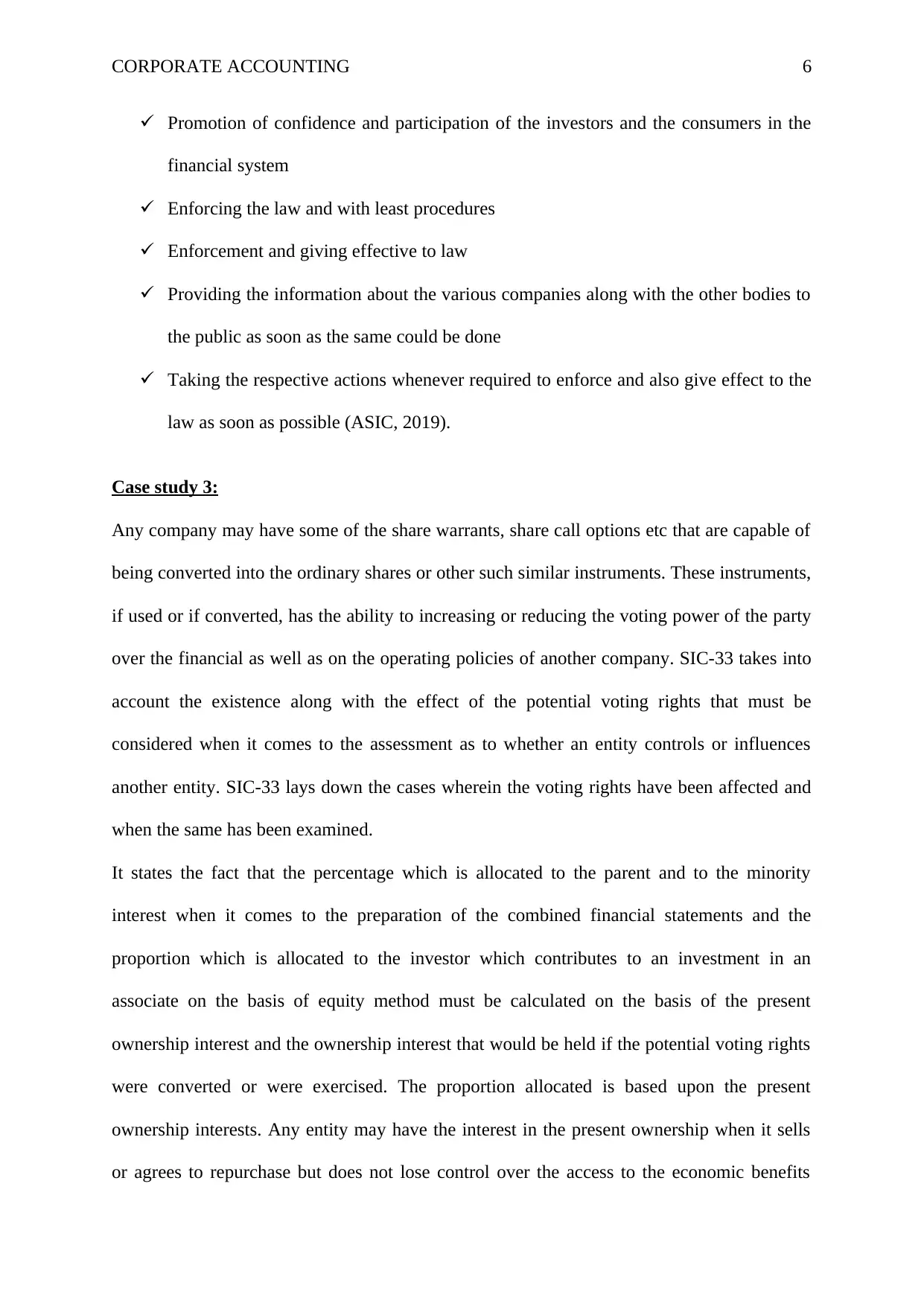
CORPORATE ACCOUNTING 6
Promotion of confidence and participation of the investors and the consumers in the
financial system
Enforcing the law and with least procedures
Enforcement and giving effective to law
Providing the information about the various companies along with the other bodies to
the public as soon as the same could be done
Taking the respective actions whenever required to enforce and also give effect to the
law as soon as possible (ASIC, 2019).
Case study 3:
Any company may have some of the share warrants, share call options etc that are capable of
being converted into the ordinary shares or other such similar instruments. These instruments,
if used or if converted, has the ability to increasing or reducing the voting power of the party
over the financial as well as on the operating policies of another company. SIC-33 takes into
account the existence along with the effect of the potential voting rights that must be
considered when it comes to the assessment as to whether an entity controls or influences
another entity. SIC-33 lays down the cases wherein the voting rights have been affected and
when the same has been examined.
It states the fact that the percentage which is allocated to the parent and to the minority
interest when it comes to the preparation of the combined financial statements and the
proportion which is allocated to the investor which contributes to an investment in an
associate on the basis of equity method must be calculated on the basis of the present
ownership interest and the ownership interest that would be held if the potential voting rights
were converted or were exercised. The proportion allocated is based upon the present
ownership interests. Any entity may have the interest in the present ownership when it sells
or agrees to repurchase but does not lose control over the access to the economic benefits
Promotion of confidence and participation of the investors and the consumers in the
financial system
Enforcing the law and with least procedures
Enforcement and giving effective to law
Providing the information about the various companies along with the other bodies to
the public as soon as the same could be done
Taking the respective actions whenever required to enforce and also give effect to the
law as soon as possible (ASIC, 2019).
Case study 3:
Any company may have some of the share warrants, share call options etc that are capable of
being converted into the ordinary shares or other such similar instruments. These instruments,
if used or if converted, has the ability to increasing or reducing the voting power of the party
over the financial as well as on the operating policies of another company. SIC-33 takes into
account the existence along with the effect of the potential voting rights that must be
considered when it comes to the assessment as to whether an entity controls or influences
another entity. SIC-33 lays down the cases wherein the voting rights have been affected and
when the same has been examined.
It states the fact that the percentage which is allocated to the parent and to the minority
interest when it comes to the preparation of the combined financial statements and the
proportion which is allocated to the investor which contributes to an investment in an
associate on the basis of equity method must be calculated on the basis of the present
ownership interest and the ownership interest that would be held if the potential voting rights
were converted or were exercised. The proportion allocated is based upon the present
ownership interests. Any entity may have the interest in the present ownership when it sells
or agrees to repurchase but does not lose control over the access to the economic benefits
⊘ This is a preview!⊘
Do you want full access?
Subscribe today to unlock all pages.

Trusted by 1+ million students worldwide
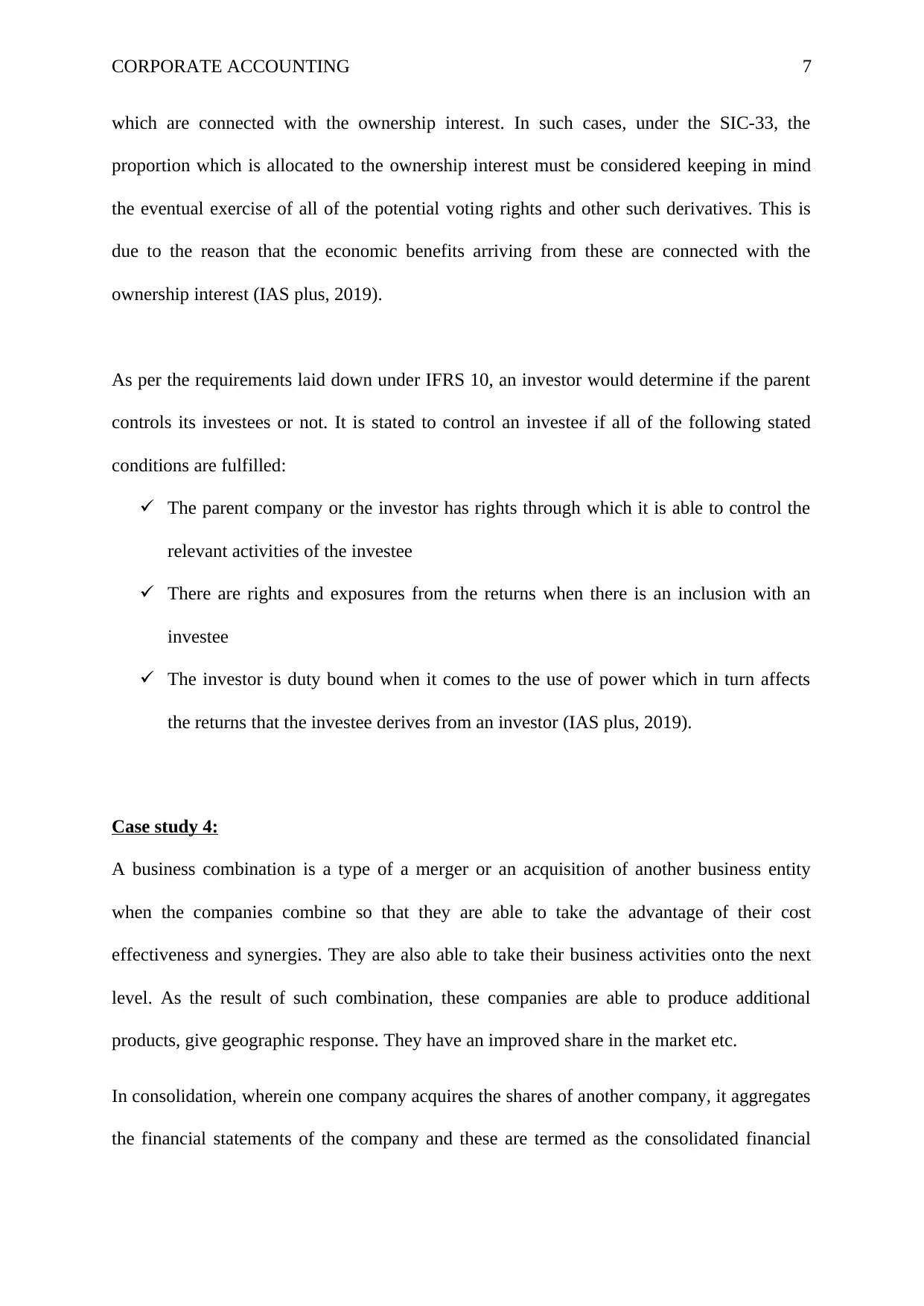
CORPORATE ACCOUNTING 7
which are connected with the ownership interest. In such cases, under the SIC-33, the
proportion which is allocated to the ownership interest must be considered keeping in mind
the eventual exercise of all of the potential voting rights and other such derivatives. This is
due to the reason that the economic benefits arriving from these are connected with the
ownership interest (IAS plus, 2019).
As per the requirements laid down under IFRS 10, an investor would determine if the parent
controls its investees or not. It is stated to control an investee if all of the following stated
conditions are fulfilled:
The parent company or the investor has rights through which it is able to control the
relevant activities of the investee
There are rights and exposures from the returns when there is an inclusion with an
investee
The investor is duty bound when it comes to the use of power which in turn affects
the returns that the investee derives from an investor (IAS plus, 2019).
Case study 4:
A business combination is a type of a merger or an acquisition of another business entity
when the companies combine so that they are able to take the advantage of their cost
effectiveness and synergies. They are also able to take their business activities onto the next
level. As the result of such combination, these companies are able to produce additional
products, give geographic response. They have an improved share in the market etc.
In consolidation, wherein one company acquires the shares of another company, it aggregates
the financial statements of the company and these are termed as the consolidated financial
which are connected with the ownership interest. In such cases, under the SIC-33, the
proportion which is allocated to the ownership interest must be considered keeping in mind
the eventual exercise of all of the potential voting rights and other such derivatives. This is
due to the reason that the economic benefits arriving from these are connected with the
ownership interest (IAS plus, 2019).
As per the requirements laid down under IFRS 10, an investor would determine if the parent
controls its investees or not. It is stated to control an investee if all of the following stated
conditions are fulfilled:
The parent company or the investor has rights through which it is able to control the
relevant activities of the investee
There are rights and exposures from the returns when there is an inclusion with an
investee
The investor is duty bound when it comes to the use of power which in turn affects
the returns that the investee derives from an investor (IAS plus, 2019).
Case study 4:
A business combination is a type of a merger or an acquisition of another business entity
when the companies combine so that they are able to take the advantage of their cost
effectiveness and synergies. They are also able to take their business activities onto the next
level. As the result of such combination, these companies are able to produce additional
products, give geographic response. They have an improved share in the market etc.
In consolidation, wherein one company acquires the shares of another company, it aggregates
the financial statements of the company and these are termed as the consolidated financial
Paraphrase This Document
Need a fresh take? Get an instant paraphrase of this document with our AI Paraphraser
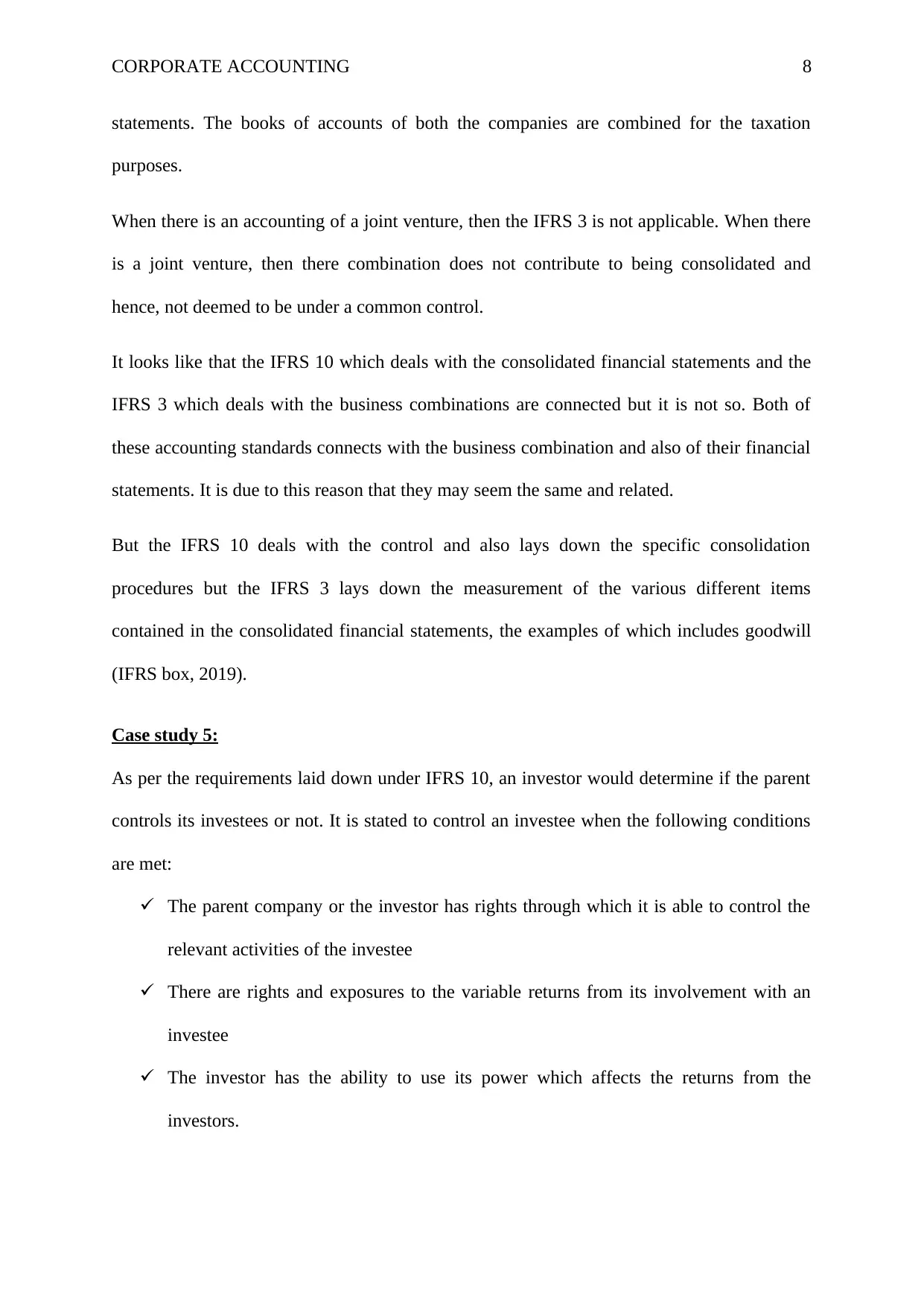
CORPORATE ACCOUNTING 8
statements. The books of accounts of both the companies are combined for the taxation
purposes.
When there is an accounting of a joint venture, then the IFRS 3 is not applicable. When there
is a joint venture, then there combination does not contribute to being consolidated and
hence, not deemed to be under a common control.
It looks like that the IFRS 10 which deals with the consolidated financial statements and the
IFRS 3 which deals with the business combinations are connected but it is not so. Both of
these accounting standards connects with the business combination and also of their financial
statements. It is due to this reason that they may seem the same and related.
But the IFRS 10 deals with the control and also lays down the specific consolidation
procedures but the IFRS 3 lays down the measurement of the various different items
contained in the consolidated financial statements, the examples of which includes goodwill
(IFRS box, 2019).
Case study 5:
As per the requirements laid down under IFRS 10, an investor would determine if the parent
controls its investees or not. It is stated to control an investee when the following conditions
are met:
The parent company or the investor has rights through which it is able to control the
relevant activities of the investee
There are rights and exposures to the variable returns from its involvement with an
investee
The investor has the ability to use its power which affects the returns from the
investors.
statements. The books of accounts of both the companies are combined for the taxation
purposes.
When there is an accounting of a joint venture, then the IFRS 3 is not applicable. When there
is a joint venture, then there combination does not contribute to being consolidated and
hence, not deemed to be under a common control.
It looks like that the IFRS 10 which deals with the consolidated financial statements and the
IFRS 3 which deals with the business combinations are connected but it is not so. Both of
these accounting standards connects with the business combination and also of their financial
statements. It is due to this reason that they may seem the same and related.
But the IFRS 10 deals with the control and also lays down the specific consolidation
procedures but the IFRS 3 lays down the measurement of the various different items
contained in the consolidated financial statements, the examples of which includes goodwill
(IFRS box, 2019).
Case study 5:
As per the requirements laid down under IFRS 10, an investor would determine if the parent
controls its investees or not. It is stated to control an investee when the following conditions
are met:
The parent company or the investor has rights through which it is able to control the
relevant activities of the investee
There are rights and exposures to the variable returns from its involvement with an
investee
The investor has the ability to use its power which affects the returns from the
investors.
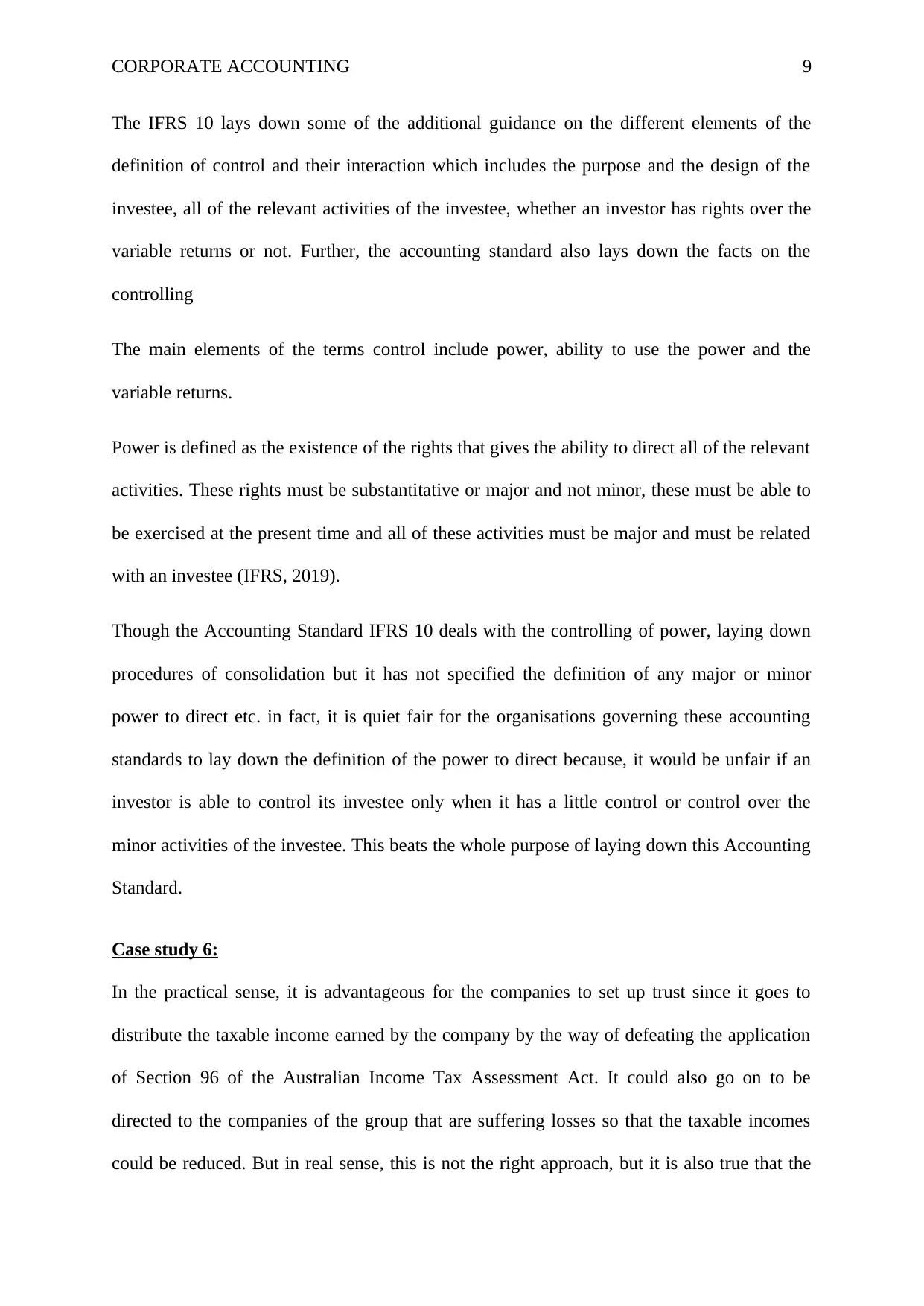
CORPORATE ACCOUNTING 9
The IFRS 10 lays down some of the additional guidance on the different elements of the
definition of control and their interaction which includes the purpose and the design of the
investee, all of the relevant activities of the investee, whether an investor has rights over the
variable returns or not. Further, the accounting standard also lays down the facts on the
controlling
The main elements of the terms control include power, ability to use the power and the
variable returns.
Power is defined as the existence of the rights that gives the ability to direct all of the relevant
activities. These rights must be substantitative or major and not minor, these must be able to
be exercised at the present time and all of these activities must be major and must be related
with an investee (IFRS, 2019).
Though the Accounting Standard IFRS 10 deals with the controlling of power, laying down
procedures of consolidation but it has not specified the definition of any major or minor
power to direct etc. in fact, it is quiet fair for the organisations governing these accounting
standards to lay down the definition of the power to direct because, it would be unfair if an
investor is able to control its investee only when it has a little control or control over the
minor activities of the investee. This beats the whole purpose of laying down this Accounting
Standard.
Case study 6:
In the practical sense, it is advantageous for the companies to set up trust since it goes to
distribute the taxable income earned by the company by the way of defeating the application
of Section 96 of the Australian Income Tax Assessment Act. It could also go on to be
directed to the companies of the group that are suffering losses so that the taxable incomes
could be reduced. But in real sense, this is not the right approach, but it is also true that the
The IFRS 10 lays down some of the additional guidance on the different elements of the
definition of control and their interaction which includes the purpose and the design of the
investee, all of the relevant activities of the investee, whether an investor has rights over the
variable returns or not. Further, the accounting standard also lays down the facts on the
controlling
The main elements of the terms control include power, ability to use the power and the
variable returns.
Power is defined as the existence of the rights that gives the ability to direct all of the relevant
activities. These rights must be substantitative or major and not minor, these must be able to
be exercised at the present time and all of these activities must be major and must be related
with an investee (IFRS, 2019).
Though the Accounting Standard IFRS 10 deals with the controlling of power, laying down
procedures of consolidation but it has not specified the definition of any major or minor
power to direct etc. in fact, it is quiet fair for the organisations governing these accounting
standards to lay down the definition of the power to direct because, it would be unfair if an
investor is able to control its investee only when it has a little control or control over the
minor activities of the investee. This beats the whole purpose of laying down this Accounting
Standard.
Case study 6:
In the practical sense, it is advantageous for the companies to set up trust since it goes to
distribute the taxable income earned by the company by the way of defeating the application
of Section 96 of the Australian Income Tax Assessment Act. It could also go on to be
directed to the companies of the group that are suffering losses so that the taxable incomes
could be reduced. But in real sense, this is not the right approach, but it is also true that the
⊘ This is a preview!⊘
Do you want full access?
Subscribe today to unlock all pages.

Trusted by 1+ million students worldwide
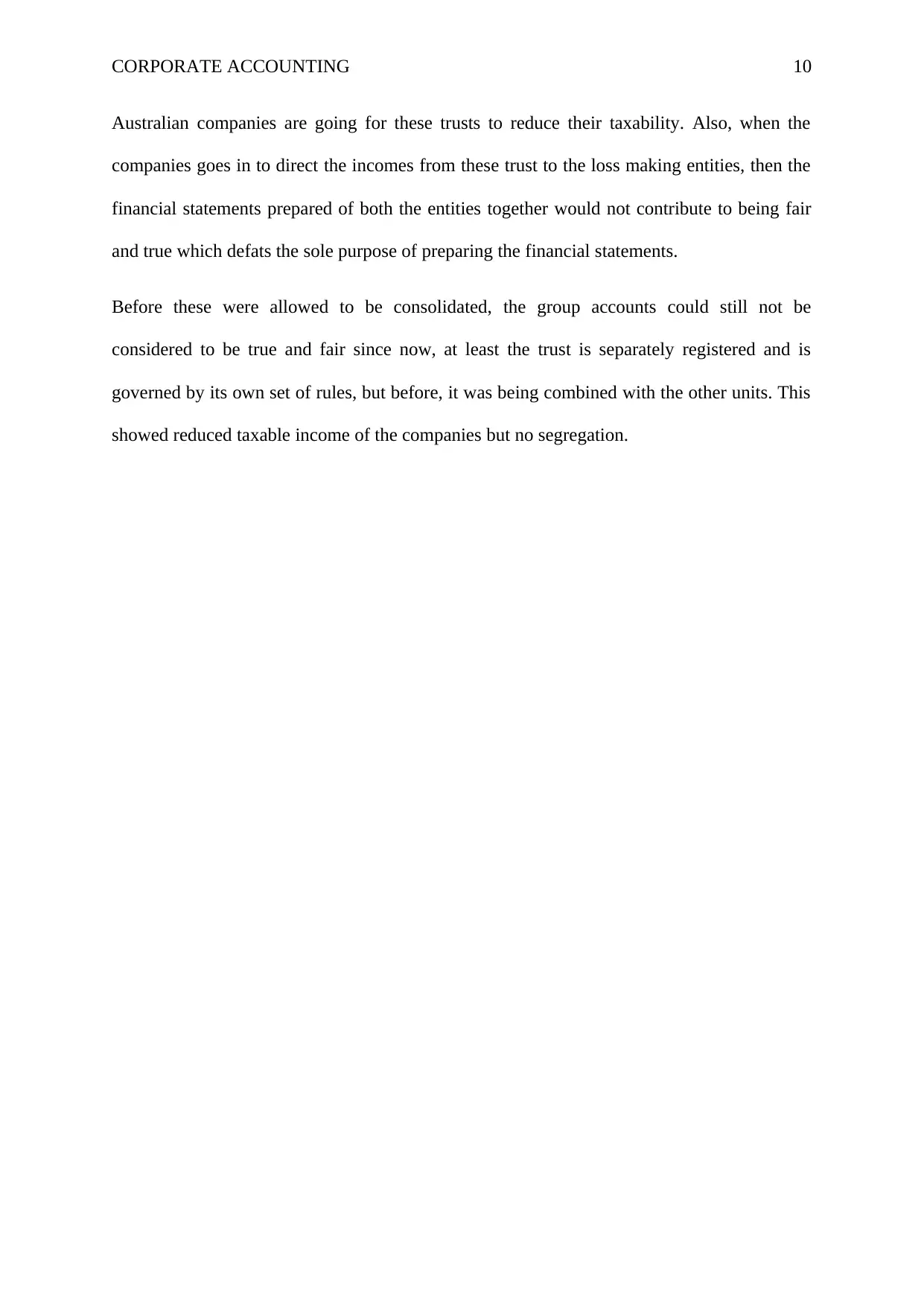
CORPORATE ACCOUNTING 10
Australian companies are going for these trusts to reduce their taxability. Also, when the
companies goes in to direct the incomes from these trust to the loss making entities, then the
financial statements prepared of both the entities together would not contribute to being fair
and true which defats the sole purpose of preparing the financial statements.
Before these were allowed to be consolidated, the group accounts could still not be
considered to be true and fair since now, at least the trust is separately registered and is
governed by its own set of rules, but before, it was being combined with the other units. This
showed reduced taxable income of the companies but no segregation.
Australian companies are going for these trusts to reduce their taxability. Also, when the
companies goes in to direct the incomes from these trust to the loss making entities, then the
financial statements prepared of both the entities together would not contribute to being fair
and true which defats the sole purpose of preparing the financial statements.
Before these were allowed to be consolidated, the group accounts could still not be
considered to be true and fair since now, at least the trust is separately registered and is
governed by its own set of rules, but before, it was being combined with the other units. This
showed reduced taxable income of the companies but no segregation.
Paraphrase This Document
Need a fresh take? Get an instant paraphrase of this document with our AI Paraphraser
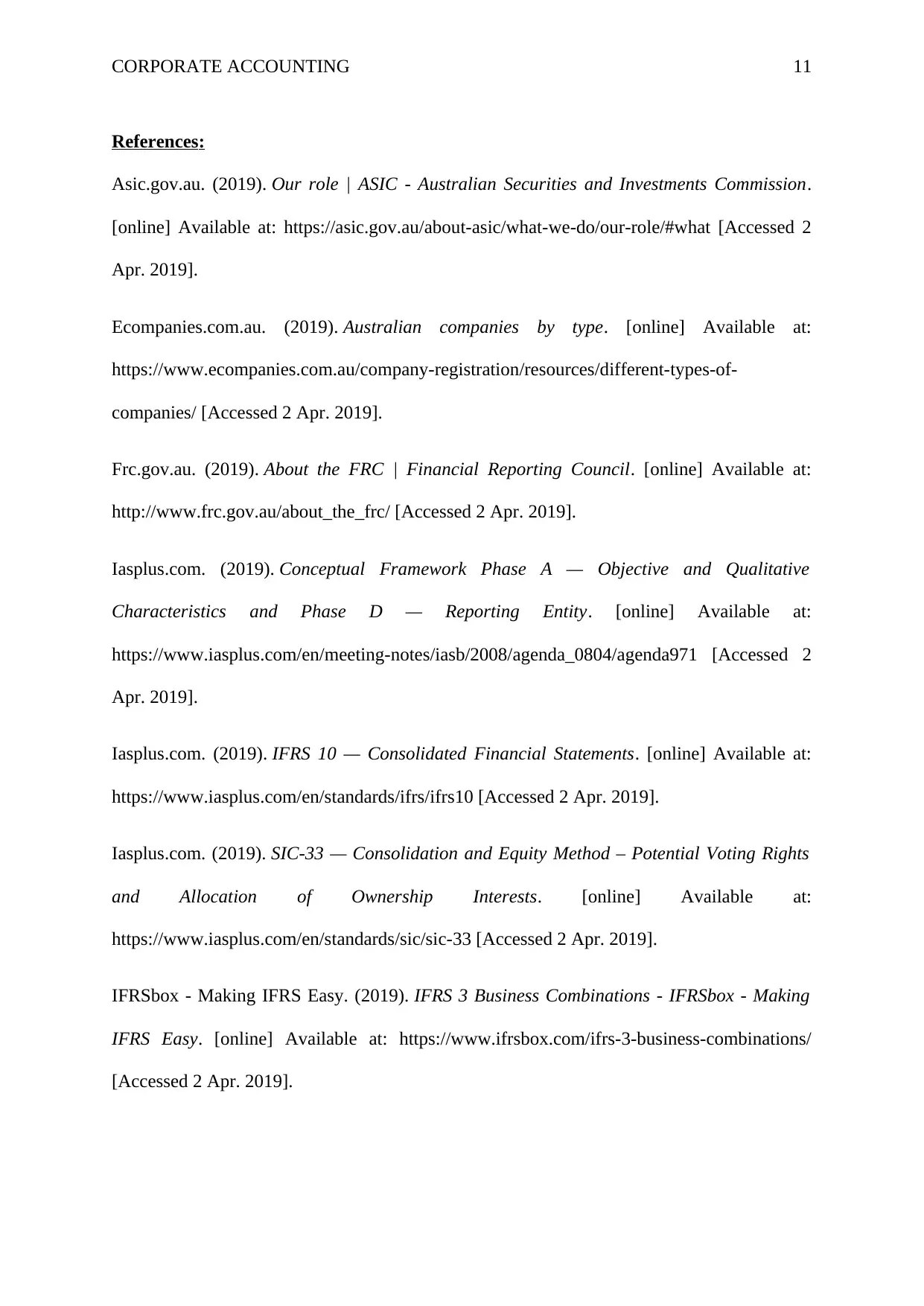
CORPORATE ACCOUNTING 11
References:
Asic.gov.au. (2019). Our role | ASIC - Australian Securities and Investments Commission.
[online] Available at: https://asic.gov.au/about-asic/what-we-do/our-role/#what [Accessed 2
Apr. 2019].
Ecompanies.com.au. (2019). Australian companies by type. [online] Available at:
https://www.ecompanies.com.au/company-registration/resources/different-types-of-
companies/ [Accessed 2 Apr. 2019].
Frc.gov.au. (2019). About the FRC | Financial Reporting Council. [online] Available at:
http://www.frc.gov.au/about_the_frc/ [Accessed 2 Apr. 2019].
Iasplus.com. (2019). Conceptual Framework Phase A — Objective and Qualitative
Characteristics and Phase D — Reporting Entity. [online] Available at:
https://www.iasplus.com/en/meeting-notes/iasb/2008/agenda_0804/agenda971 [Accessed 2
Apr. 2019].
Iasplus.com. (2019). IFRS 10 — Consolidated Financial Statements. [online] Available at:
https://www.iasplus.com/en/standards/ifrs/ifrs10 [Accessed 2 Apr. 2019].
Iasplus.com. (2019). SIC-33 — Consolidation and Equity Method – Potential Voting Rights
and Allocation of Ownership Interests. [online] Available at:
https://www.iasplus.com/en/standards/sic/sic-33 [Accessed 2 Apr. 2019].
IFRSbox - Making IFRS Easy. (2019). IFRS 3 Business Combinations - IFRSbox - Making
IFRS Easy. [online] Available at: https://www.ifrsbox.com/ifrs-3-business-combinations/
[Accessed 2 Apr. 2019].
References:
Asic.gov.au. (2019). Our role | ASIC - Australian Securities and Investments Commission.
[online] Available at: https://asic.gov.au/about-asic/what-we-do/our-role/#what [Accessed 2
Apr. 2019].
Ecompanies.com.au. (2019). Australian companies by type. [online] Available at:
https://www.ecompanies.com.au/company-registration/resources/different-types-of-
companies/ [Accessed 2 Apr. 2019].
Frc.gov.au. (2019). About the FRC | Financial Reporting Council. [online] Available at:
http://www.frc.gov.au/about_the_frc/ [Accessed 2 Apr. 2019].
Iasplus.com. (2019). Conceptual Framework Phase A — Objective and Qualitative
Characteristics and Phase D — Reporting Entity. [online] Available at:
https://www.iasplus.com/en/meeting-notes/iasb/2008/agenda_0804/agenda971 [Accessed 2
Apr. 2019].
Iasplus.com. (2019). IFRS 10 — Consolidated Financial Statements. [online] Available at:
https://www.iasplus.com/en/standards/ifrs/ifrs10 [Accessed 2 Apr. 2019].
Iasplus.com. (2019). SIC-33 — Consolidation and Equity Method – Potential Voting Rights
and Allocation of Ownership Interests. [online] Available at:
https://www.iasplus.com/en/standards/sic/sic-33 [Accessed 2 Apr. 2019].
IFRSbox - Making IFRS Easy. (2019). IFRS 3 Business Combinations - IFRSbox - Making
IFRS Easy. [online] Available at: https://www.ifrsbox.com/ifrs-3-business-combinations/
[Accessed 2 Apr. 2019].

CORPORATE ACCOUNTING 12
IFRSbox - Making IFRS Easy. (2019). IFRS 10 Consolidated Financial Statements -
IFRSbox - Making IFRS Easy. [online] Available at: https://www.ifrsbox.com/ifrs-10-
consolidated-financial-statements/ [Accessed 2 Apr. 2019].
IFRSbox - Making IFRS Easy. (2019). IFRS 10 Consolidated Financial Statements -
IFRSbox - Making IFRS Easy. [online] Available at: https://www.ifrsbox.com/ifrs-10-
consolidated-financial-statements/ [Accessed 2 Apr. 2019].
⊘ This is a preview!⊘
Do you want full access?
Subscribe today to unlock all pages.

Trusted by 1+ million students worldwide
1 out of 12
Related Documents
Your All-in-One AI-Powered Toolkit for Academic Success.
+13062052269
info@desklib.com
Available 24*7 on WhatsApp / Email
![[object Object]](/_next/static/media/star-bottom.7253800d.svg)
Unlock your academic potential
Copyright © 2020–2025 A2Z Services. All Rights Reserved. Developed and managed by ZUCOL.





